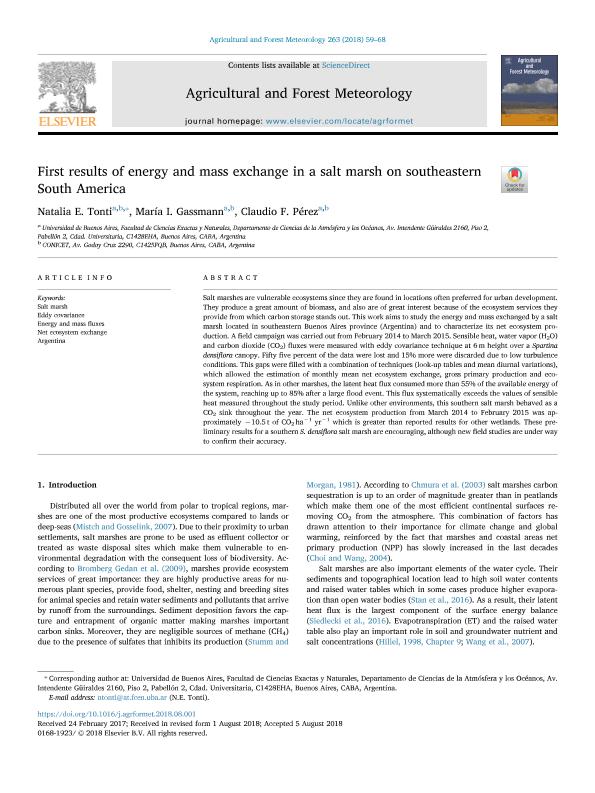Mostrar el registro sencillo del ítem
dc.contributor.author
Tonti, Natalia Edith

dc.contributor.author
Gassmann, María Isabel

dc.contributor.author
Perez, Claudio Fabian

dc.date.available
2022-07-15T16:04:41Z
dc.date.issued
2018-12
dc.identifier.citation
Tonti, Natalia Edith; Gassmann, María Isabel; Perez, Claudio Fabian; First results of energy and mass exchange in a salt marsh on southeastern South America; Elsevier Science; Agricultural And Forest Meteorology; 263; 12-2018; 59-68
dc.identifier.issn
0168-1923
dc.identifier.uri
http://hdl.handle.net/11336/162208
dc.description.abstract
Salt marshes are vulnerable ecosystems since they are found in locations often preferred for urban development. They produce a great amount of biomass, and also are of great interest because of the ecosystem services they provide from which carbon storage stands out. This work aims to study the energy and mass exchanged by a salt marsh located in southeastern Buenos Aires province (Argentina) and to characterize its net ecosystem production. A field campaign was carried out from February 2014 to March 2015. Sensible heat, water vapor (H2O) and carbon dioxide (CO2) fluxes were measured with eddy covariance technique at 6 m height over a Spartina densiflora canopy. Fifty five percent of the data were lost and 15% more were discarded due to low turbulence conditions. This gaps were filled with a combination of techniques (look-up tables and mean diurnal variations), which allowed the estimation of monthly mean net ecosystem exchange, gross primary production and ecosystem respiration. As in other marshes, the latent heat flux consumed more than 55% of the available energy of the system, reaching up to 85% after a large flood event. This flux systematically exceeds the values of sensible heat measured throughout the study period. Unlike other environments, this southern salt marsh behaved as a CO2 sink throughout the year. The net ecosystem production from March 2014 to February 2015 was approximately −10.5 t of CO2 ha−1 yr−1 which is greater than reported results for other wetlands. These preliminary results for a southern S. densiflora salt marsh are encouraging, although new field studies are under way to confirm their accuracy.
dc.format
application/pdf
dc.language.iso
eng
dc.publisher
Elsevier Science

dc.rights
info:eu-repo/semantics/openAccess
dc.rights.uri
https://creativecommons.org/licenses/by-nc-sa/2.5/ar/
dc.subject
ARGENTINA
dc.subject
EDDY COVARIANCE
dc.subject
ENERGY AND MASS FLUXES
dc.subject
NET ECOSYSTEM EXCHANGE
dc.subject
SALT MARSH
dc.subject.classification
Meteorología y Ciencias Atmosféricas

dc.subject.classification
Ciencias de la Tierra y relacionadas con el Medio Ambiente

dc.subject.classification
CIENCIAS NATURALES Y EXACTAS

dc.title
First results of energy and mass exchange in a salt marsh on southeastern South America
dc.type
info:eu-repo/semantics/article
dc.type
info:ar-repo/semantics/artículo
dc.type
info:eu-repo/semantics/publishedVersion
dc.date.updated
2022-07-15T15:00:37Z
dc.journal.volume
263
dc.journal.pagination
59-68
dc.journal.pais
Países Bajos

dc.journal.ciudad
Amsterdam
dc.description.fil
Fil: Tonti, Natalia Edith. Universidad de Buenos Aires. Facultad de Ciencias Exactas y Naturales. Departamento de Ciencias de la Atmósfera y los Océanos; Argentina. Consejo Nacional de Investigaciones Científicas y Técnicas; Argentina
dc.description.fil
Fil: Gassmann, María Isabel. Universidad de Buenos Aires. Facultad de Ciencias Exactas y Naturales. Departamento de Ciencias de la Atmósfera y los Océanos; Argentina. Consejo Nacional de Investigaciones Científicas y Técnicas; Argentina
dc.description.fil
Fil: Perez, Claudio Fabian. Universidad de Buenos Aires. Facultad de Ciencias Exactas y Naturales. Departamento de Ciencias de la Atmósfera y los Océanos; Argentina. Consejo Nacional de Investigaciones Científicas y Técnicas; Argentina
dc.journal.title
Agricultural And Forest Meteorology

dc.relation.alternativeid
info:eu-repo/semantics/altIdentifier/url/https://www.sciencedirect.com/science/article/pii/S0168192318302612
dc.relation.alternativeid
info:eu-repo/semantics/altIdentifier/doi/http://dx.doi.org/10.1016/j.agrformet.2018.08.001
Archivos asociados
